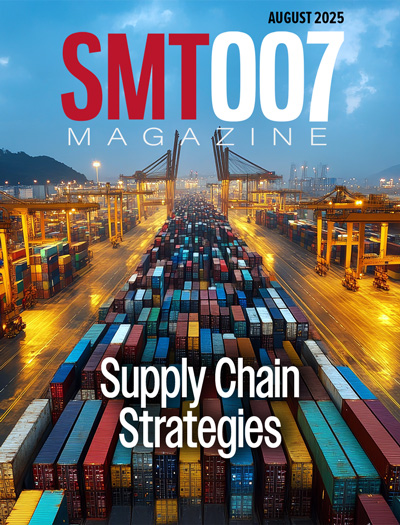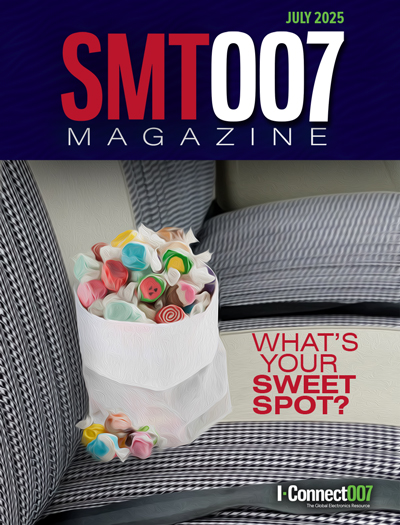-

- News
- Books
Featured Books
- smt007 Magazine
Latest Issues
Current Issue
Spotlight on India
We invite you on a virtual tour of India’s thriving ecosystem, guided by the Global Electronics Association’s India office staff, who share their insights into the region’s growth and opportunities.

Supply Chain Strategies
A successful brand is built on strong customer relationships—anchored by a well-orchestrated supply chain at its core. This month, we look at how managing your supply chain directly influences customer perception.

What's Your Sweet Spot?
Are you in a niche that’s growing or shrinking? Is it time to reassess and refocus? We spotlight companies thriving by redefining or reinforcing their niche. What are their insights?
- Articles
- Columns
- Links
- Media kit
||| MENU - smt007 Magazine
Low-temperature Solder Paste Process Advantages
October 31, 2018 | Traian C. Cucu, Alpha Assembly Solutions, and Ioan Plotog and Mihai Branzei, Politechnica University of BucharestEstimated reading time: 7 minutes
Figure 12: Combined voiding performance for OM-550, HRL1 alloy, solder paste (data).
Figure 13: Combine voiding performance for OM-550, HRL1 alloy, solder paste (pictures, air reflow).
Figure 14: Combine voiding performance for OM-550, HRL1 alloy, solder paste (pictures, nitrogen reflow).
Drop Shock
The mechanical performance of the joints formed with the HRL1 alloy from the solder paste and the SAC305 from the BGA spheres were evaluated using JEDEC service condition B for drop shock. The drop shock data is presented in Figure 15.
Figure 15: Low-temperature reflow profile.
Thermal Cycling Test
The IPC 9701-A method was used for the thermal cycling test. Table 1 shows the thermal cycling performance of the joint formed in a low-temperature reflow process using a solder paste with HRL1 alloy and BGA components withSAC305 spheres.
Table 1: Thermal cycling performance.
Conclusions
In this body of work, we have summarized the evaluation results of our latest low-temperature chemistry platform that is capable of using powder made of HRL1 and off-eutectic alloys. Based on the data presented, we make the following conclusions:
- The printing performance of the new platform (OM-550) is on par with the performance of the existing SAC chemistry. Concerning rheology, there are few differences from existing SAC chemistries used today in the industry, which allows for the new platform to be dropped into an existing printing process using the normal fine-tuning procedures to optimize the printing process and ensure a smooth transition from a PCB assembly process using SAC alloys to a low-temperature assembly process.
- Based on the printing results, the chemistry proved consistently printed on stencils with an AR equal to or larger than 0.6 (as observed in the testing, even lower ARs were possible during our testing).
- The printing process indicators show consistent performance for the new low-temperature assembly platform that facilitates the new assembly process implementation with minimal impact on the assembly line equipment and makes it possible to achieve the full benefits of a low-temperature process with minimal cost impact.
- The required reflow process can be easily achieved using existing equipment. The reflow-temperature envelope is shaped similarly to the envelope of a SAC reflow process.
- For a reflow envelope, as previously mentioned, we observed that a peak temperature of 190°C or higher is preferred for the formation of a mixed alloy joint with improved mechanical performance.
- The performance of the mixed joint formed with HRL1 alloy is substantially superior to the one formed with the eutectic SnBiAg alloy; this was very close in performance to a joint formed with SAC305 alloy.
- The new material is enabling the use of a low-temperature PCB assembly process that brings the full benefits of low environmental impact through lower energy consumption and the reduction of the carbon footprint for the assembly process with minimal impact on the joint mechanical properties.
OM-550, HRL1 solder paste proved to be a strong option for the applications where a low-temperature process can be employed, including assembly where mixed alloy joints are going to be formed.
References
1. R. Strauss, SMT Soldering Handbook, Butterworth-Heinemann Linacre House, Oxford, 1998.
2. Traian C. Cucu, Norocel-Dragos Codreanu, & Ioan Plotog, “Reflow process using lead-free materials: Basics and comparison with tin-lead process,” 2006.
3. Klein Wassink, Soldering in Electronics (2nd Edition), 1989.
4. P. Svasta, I. Plotog, T. Cucu, A. Vasile, & A. Marin, “4 P Soldering Model for Solder Joints Quality Assessment,” ISSE 2009, The 32nd International Spring Seminar on Electronics Technology, proceedings from Brno, Czech Republic, May 2009.
5. Lenovo Newsroom, “Lenovo™ Announces Breakthrough, Innovative PC Manufacturing Process,” 2017.
6. Ioan Plotog, Constantin Jianu, Carmen Turcu, Traian C. Cucu, & Norocel D. Codreanu, “Multi-criterial Approach for Implementing of Lead-free Technology,” 4th European Microelectronics and Packaging Symposium, proceedings from Terme Catez, Slovenia, May 2006, pp. 301–306.
This article was originally published in the proceedings of SMTA International 2017.
Visit I-007eBooks to download your copy of Alpha's micro eBook today:
The Printed Circuit Assembler’s Guide to… Low-Temperature Soldering
Testimonial
"The I-Connect007 team is outstanding—kind, responsive, and a true marketing partner. Their design team created fresh, eye-catching ads, and their editorial support polished our content to let our brand shine. Thank you all! "
Sweeney Ng - CEE PCBSuggested Items
Koh Young, Fuji, and Kurtz ERSA Drive Smart Manufacturing Solutions for EV and Automotive Electronics at Kunshan, China Technical Seminar
09/11/2025 | Koh YoungKoh Young Technology, the global leader in True 3D measurement-based inspection solutions, partnered with Fuji Corporation and Kurtz ERSA to host an exclusive technical seminar for leading automotive manufacturers in East China. Held on September 4 at Fuji’s factory in Kunshan, the event gathered participants representing over 35 companies.
MacDermid Alpha Presents at SMTA New Delhi, Bangalore Chapter, on Flux–OSP Interaction
09/09/2025 | MacDermid Alpha Electronics SolutionsMacDermid Alpha contributes technical insights on OSP solderability at the Bangalore Chapter, SMTA reinforcing commitment to knowledge-sharing and industry collaboration.
Electra’s ElectraJet EMJ110 Inkjet Soldermask Now in Black & Blue at Sunrise Electronics
09/08/2025 | Electra Polymers LtdFollowing the successful deployment of Electra’s Green EMJ110 Inkjet Soldermask on KLA’s Orbotech Neos™ platform at Sunrise Electronics in Elk Grove Village, Illinois, production has now moved beyond green.
Absolute EMS: The Science of the Perfect Solder Joint
09/05/2025 | Absolute EMS, Inc.Absolute EMS, Inc., a six-time award-winning provider of fast turnaround, turnkey contract electronic manufacturing services (EMS), is drawing attention to the critical role of 3D Solder Paste Inspection (SPI) in ensuring the reliability of both FLEX and rigid printed circuit board assemblies (PCBAs).
Indium Corporation to Highlight High-Reliability Solder Solutions at SMTA Guadalajara Expo
09/04/2025 | Indium CorporationIndium Corporation, a leading materials refiner, smelter, manufacturer, and supplier to the global electronics, semiconductor, thin-film, and thermal management markets, will feature a range of innovative, high-reliability solder products for printed circuit board assembly (PCBA) at the SMTA Guadalajara Expo and Tech Forum, to be held September 17-18 in Guadalajara, Mexico.


